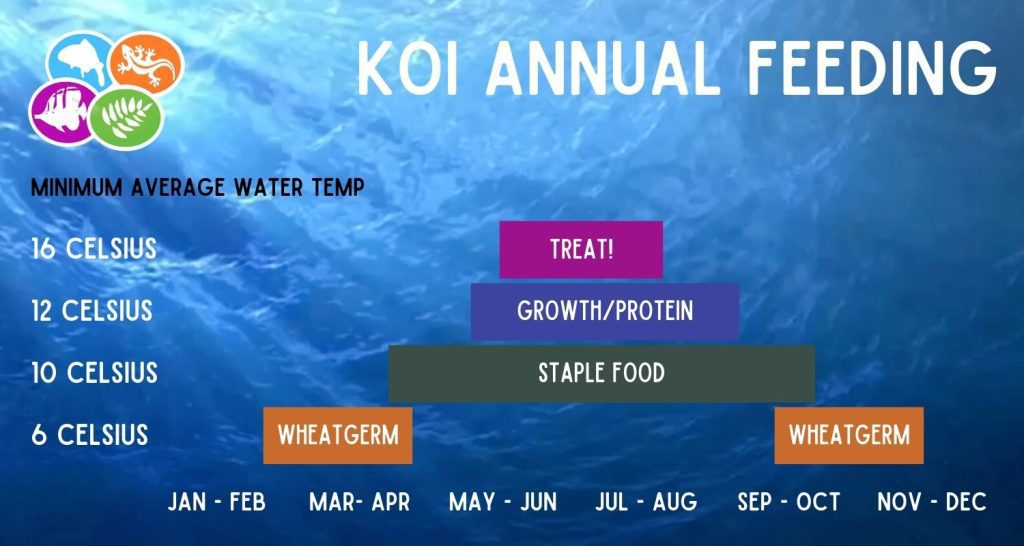Feeding Koi. The what, when, and why.
5 min read
A quick and easy to follow guide on what to feed to your Koi. #
Feeding Koi can be a delicate balancing act. As a Koi keeper you’ll have come to terms with just how complicated fish food can be. It seems to come as something of a shock to new hobbyists that animals have specific dietary needs. The range of foods available from different producers that all boast different supplements can be confusing. Doubly so when you start including variables like temperature into the mix.

Feeding Koi in Winter & Spring #
Generally speaking, don’t. You’ll notice our chart is blank across December, January and most of February.
If the average water temperature in your pond is below 6° celsius then your fish should be in hibernation mode. Even if you did throw some food in and they ate it, their body wouldn’t digest it. This means it would be sat rotting in the gut of your fish. This is clearly not something you want to happen. If they didn’t eat it, it would then begin to rot in your pond. Also definitely not something you want to happen.
As things begin to warm up you can start looking at feeding again. Remember, the ability for your fish to take up Protein from their food is still lessened by the colder temperature. Wheatgerm food is low in protein but has boosted levels of everything else your Koi need to get going again.
Feeding Koi in Summer & Autumn #
Koi are greedy. They’re prone to over-eating and then producing the inevitable waste in quantities that beggars belief. Being prepared for this and sticking to a feeding regime will help manage this for you. Not only will this end up easing the pressure on your poor filter having to deal with the results of potential over-feeding, but it should ease up on your wallet, too.
You’ll need a Staple food that you give to your Koi from around the end of March until mid-October that provides them with the basic requirements. If you’re looking to boost their growth then a high protein food is required. Remember this needs to be used in warmer temperatures so your Koi can use the protein properly. Use this between mid-May and September.
To make life even easier, we’ve even colour coded our chart to match Nishikoi’s food range!
It is key to remember that your fish, despite being in captivity, are ‘wild’. Encourage them to practise behaviours they would normally use in their natural habitat. Being slightly peckish and nosing around the pond looking for food they may have missed is good for their general muscle growth and health. As noted previously, they’re greedy devils.
Having said that, you do actually need to feed them. Little and often is the key phrase here. Giving enough food so that it is all gone in about 5 minutes is a good benchmark. This can be done as often as your daily routine allows. If growth is your aim then do it more often. If not then stick to less often. Like all animals your fish will fall into the rhythm that suits them and so will you.
An added bonus of feeding like this is your Koi will begin to come to the edges of the pond when you approach expecting food. This is a great opportunity to inspect your pets with a visual health check, admire them up close, and maybe begin trying out some hand feeding with them.
Treats #
We all like to treat our pets. It’s a lovely thing to do and seeing any animal enjoy something is good for the soul. Remember to treat your Koi sparingly – they’re never as hungry as they’d have you believe! As with all treats, they should make up part of a healthy, balanced diet. A great option is Evolution Aqua’s Pond Treats. A tub with four compartments for some of your fish’s favourite treats: Silkworm, Gammarus, Shrimp and Mealworm. These provide a natural, high protein treat to supplement the diet of all pond fish.
General tips for feeding koi #
Consider a feeding ring. If you have a fairly heavily planted pond you may find food floats off and disappears amongst your plants. There, if not discovered, it will begin to rot in your water – which you don’t want. A feeding ring is an inexpensive fix to this problem. It keeps all the koi’s food in one place so you can monitor what is left and how long it takes them to eat it. Grab yours here.
Little and often. We can’t stress this enough – Koi are greedy and will over-eat if you give them half a chance. They’re also absolute poo machines so remember what goes in will come out. Many keepers make more work for themselves (and their filters!) by being too heavy handed when feeding koi.
Thermometers are your friend. Our chart is super useful and helpful but when it comes to the months it is only a guide. The temperature of your water should determine the food you’re giving to your Koi.
If you’ve got any more tips or comments about feeding koi, or keeping koi in general why not share them on our social media!






